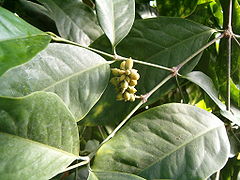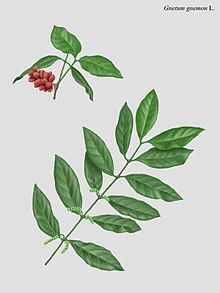- Gnetum gnemon
-
Gnetum gnemon Scientific classification Kingdom: Plantae Division: Gnetophyta Class: Gnetopsida Order: Gnetales Family: Gnetaceae Genus: Gnetum Species: G. gnemon Binomial name Gnetum gnemon
L.Gnetum gnemon is a species of Gnetum native to southeast Asia and the western Pacific Ocean islands, from Assam south and east through Indonesia and Malaysia to the Philippines and Fiji. Common names include melinjo or belinjo (Indonesian language), bago (Malay language, Tagalog language), muling (Aceh language) peesae (Pattani Malay), dae (Kwara'ae language), phakmiang (Thai language) and bét, rau bép, rau danh or gắm (Vietnamese language). They are sometimes called padi oats or paddy oats.
It is a small to medium-size tree (unlike most other Gnetum species, which are lianas), growing to 15–20 m tall. The leaves are evergreen, opposite, 8–20 cm long and 3–10 cm broad, entire, emerging bronze-coloured, maturing glossy dark green. The fruit-like strobilus consist of little but skin and a large nut-like seed 2–4 cm long inside.
Fleshy strobili weigh about 5.5 g, the seed alone 3.8 g. Strobili mature mainly from June to September in NE Philippines. The red strobili are eaten by birds, mammals and reptiles.
Contents
Uses
Melinjo is native to Indonesia and very popular in this country. It is widely used in Indonesian cuisine. The seeds are used for sayur asem (sour vegetables soup) and also, ground into flour and deep-fried as crackers (emping, a type of krupuk). The crackers have a slightly bitter taste and are frequently served as a snack or accompaniment to Indonesian dishes. The leaves are also commonly used for vegetables dishes in Indonesia.
This plant is commonly cultivated throughout the Aceh region and is regarded as a vegetable of high status. Its flower, young leaves and fruit are used as ingredients in traditional vegetable curry called kuah pliek. This dish is served on all important traditional occasions, such as khanduri and keureudja. In the Pidie district, the women pick the ripe fruit (its skin color is red) and make keureupuk muling from it.
Melinjo crackers were part of the dinner menu during Barack Obama's state visit to Indonesia in 2010, where he praised the crackers, alongside the Bakso (meatball soup) and the Nasi Goreng (fried rice), as being delicious. [1]
Recently, Japanese scientists found that Gnetum gnemon is not the cause of gout (uric acid disease).[2]
At the present, Melinjo Extract is produced and supervised under cooperation between Indonesian Agricultural Association (NOFA (id:KTNA) ; Ikamaja's Mother Organization) and JASMELINDO (Japanese Non-Profit Organization), to protect certain profit for Indonesian farmers.
Phytochemicals
Recently, it has been discovered that melinjo strobili is rich in a stilbenoid composed of resveratrol and identified as a dimer. This result was published in XXIII International Conference on Polyphenols, Canada, in 2006.[citation needed]
Melinjo resveratrol, having antibacterial and antioxidative activity,[3] works as a food preservative, off flavour inhibitor and taste enhancer.[4] This species may have applications in food industries which do not use any synthetic chemicals in their processes.
Four new stilbene oligomers, gnemonol G, H, I and J, were isolated from acetone extract of the root of Gnetum gnemon along with five known stilbenoids, ampelopsin E, cis-ampelopsin E, gnetin C, D and E.[5]
The extraction of dried leaf of Gnetum gnemon with acetone water (1:1) gave C-glycosylflavones (isovitexin, vicenin II, isoswertisin, swertisin, swertiajaponin, isoswertiajaponin).[6]
The separation of a 50% ethanol extract of the dried endospoerms yielded gnetin C, gnetin L (new stilbenoid), gnemonosides A, C and D, and resveratrol which were tested for DPPH radical scavenging action, antimicrobial activity and inhibition of lipase and α-amylase from porcine pancreas.[7] Gnetin C showed the best effect among these stilbenoids.
Oral administration of the 50% ethanol extract of melinjo fruit at 100 mg/kg/day significantly enhanced the production of the Th1 cytokines IL-2 and IFN-γ irrespective of concanavalin-A stimulation, whereas the production of the Th2 cytokines IL-4 and IL-5 was not affected. New stilbene glucosides gnemonoside L and gnemonoside M, and known stilbenoids resveratrol, isorhapontigenin, gnemonoside D, gnetins C and E were isolated from the extract. Gnemonoside M strongly enhanced Th1 cytokine production in cultured Peyer's patch cells from mice at 10 mg/kg/day.[8]
References
- ^ Siahaan, Armando; Camelia Pasandaran (November 10, 2010). "Cheering, Bakso and Friendship – An Indonesian Welcome Home for Obama". The Jakarta Globe. http://www.thejakartaglobe.com/home/cheering-bakso-and-friendship-an-indonesian-welcome-home-for-obama/405835.
- ^ Mori, M., et al. (2008). Relationship between Lifestyle-related Diseases with The Intake of Indonesian Traditional Fruit Melinjo Rich in Phytoestrogens. Niigata, Japan. The 4th International Niigata Symposium on Diet and Health Integrative Function of Diet in Anti-aging and Cancer Prevention.
- ^ Hisada, H., et al. (2005). Antibacterial and Antioxidative Constituents of Melinjo Seeds and Their Application to Foods. Japan. Science Links Japan.
- ^ Santoso, M., et al..(2008). Inhibition of Fish Lipid Oxidation by the Extract of Indonesia Edible Plant Seed `Melinjo`. Kyoto, Japan. Japanese Society for Food Science and Technology.
- ^ Four New Stilbene Oligomers in the Root of Gnetum gnemon. Ibrahim Iliya, Zulfiqar Ali, Toshiyuki Tanaka, Munekazu Iinuma, Miyuki Furusawa, Ken-ichi Nakaya, Jin Murata and Dedy Darnaedi, Helvetica Chimica Acta, Volume 85, Issue 8, pages 2538–2546, August 2002, DOI: 10.1002/1522-2675(200208)
- ^ Wallace, J.W. et al..(1978). C-Glycosylflavones in Gnetum gnemon, Phytochemistry, volume 17, pages 1809-1910.
- ^ Kato, E., et al. (2009). Stilbenoids Isolated from the Seeds of Melinjo (Gnetum gnemon L.) and Their Biological Activity. Japan. J. Agric Food Chem, 57 (6), 2544-2549.
- ^ Kato, H., et al. (2011). Stilbenoids from the Melinjo (Gnetum gnemon L.) Fruit Modulate Cytokine Production in Murine Peyer's Patch Cells Ex Vivo, Planta Med. Jan 25.
External links
 Media related to Gnetum gnemon at Wikimedia CommonsCategories:
Media related to Gnetum gnemon at Wikimedia CommonsCategories:- Gnetophyta
- Edible nuts and seeds
- Indonesian cuisine
- Trees
Wikimedia Foundation. 2010.



